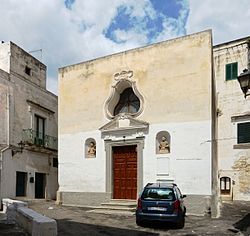Grottaglie
| Grottaglie | ||
|---|---|---|
| Comune | ||
| Comune di Grottaglie | ||

Church of Madonna del Lume.
|
||
|
||
| Location of Grottaglie in Italy | ||
| Coordinates: 40°32′N 17°26′E / 40.533°N 17.433°E | ||
| Country | Italy | |
| Region |
|
|
| Province / Metropolitan city | Taranto (TA) | |
| Frazioni | Carraro delle Vacche, Paparazio | |
| Government | ||
| • Mayor | Ciro D'Alò | |
| Area | ||
| • Total | 101 km2 (39 sq mi) | |
| Elevation | 133 m (436 ft) | |
| Population (31 December 2014) | ||
| • Total | 32,503 | |
| • Density | 320/km2 (830/sq mi) | |
| Demonym(s) | Grottagliesi | |
| Time zone | CET (UTC+1) | |
| • Summer (DST) | CEST (UTC+2) | |
| Postal code | 74023 | |
| Dialing code | 099 | |
| Patron saint | St. Francis of Geronimo, St. Cyrus | |
| Saint day | January 31 | |
| Website | Official website | |
Grottaglie is a town and comune in the province of Taranto, Apulia, in southern Italy.
Grottaglie is located in the Salento peninsula, a whole rock of limestone dividing Adriatic sea from Ionian sea. The countryside around the city is scattered with vast and deep ravines that open the ground into the heart of the limestone-rock. The landscape is characterized by the presence of such ancient and enthralling rupestrian ravine encircling the built-up area.
The name Grottaglie derives from the Latin Cryptae Aliae, meaning "many ravines", which has been inhabited since the Palaeolithic Age. The ancestral part of Grottaglie was one of the citadels in the area, referred to in Medieval documents as Casale Cryptalerum, founded during the Dark Ages by the inhabitants of the caves who sheltered there due to Saracen invasions.
The fief of Grottaglie was donated by the Norman overlords to the archbishopric of Taranto in the 11th century. In the 14th century the ecclesiastic administration provided the fief with fortifications, walls, a castle (Castello Episcopio, Italian for “archbishop’s castle”) as well as with the Chiesa Matrice ("Mother church").
Since the 15th-17th centuries the jurisdiction over Grottaglie fief was split between the ecclesiastic administration (civil law) and the lay feudal lords (criminal law, Cicinelli-Caracciolo family). Fights between these two competing authorities and periodic revolts by the heavily-taxed population were the leit-motiv of Grottaglie’s history until the abolition of feudalism (1806). After the Italian unification Grottaglie had the first urban expansion outside its Medieval walls.
Folkloristic and religious events include the commemoration-day of St. Cyrus and Easter-period when the Medieval-rooted confraternal religious orders perform their processions during the days of the Holy Week (Easter rituals include procession and pilgrimage of confrères called “Bubbli-Bubbli” through the streets of town).
...
Wikipedia


